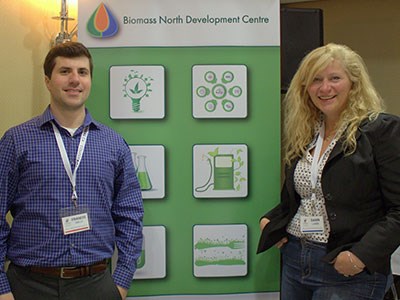By: Ella Myers
The Biomass North Development Centre is gaining traction and building momentum as it unrolls its completed Northern Ontario Biomass Strategy (which goes by the cheeky acronym NO-BS).
In the summer of 2014, the Ontario Union of Indians (OUI) and the Biomass Innovation Centre (BIC) operating out of Nipissing University signed a memorandum to develop a biomass strategy for the North. The aim was to fill a gap created by the closing of CANBIO, and ensure representation for small and medium bioeconomy enterprises.
The BIC was shut down at Nipissing University in May 2015, and the plans were put on hold as the group reformed as the Biomass North Development Centre, or Biomass North.
BIC staff Dawn Lambe and Francis Gallo were responsible for the continuation, and are now the executive director and project director, respectively. The OUI retains ownership of the strategy despite the organizational changes.
Biomass North has the same underlying focus as the BIC had: building a robust bioeconomy in Northern Ontario.
However, as a member-based sector association, Lambe said they are more driven and empowered to press for policy and regulation modernization at a government level.
Since regaining their footing, Biomass North has presented the NO-BS to trade shows, conferences and expos in Northern Ontario. Gallo presented NO-BS Biomass North’s first event, the 2015 Forestry Automation Expo on Nov. 10, in Sudbury, and to Canadian and international companies at the “speed-dating” Naturallia forum later in the week.
Delegates from Sweden, Finland and Germany ran a panel on international snapshots on bioenergy development with Lambe at the forum. Lambe said the strategy is inspired by those in Europe, and especially in Nordic countries that rely on the forestry industry. Biomass North plans to send a delegation to Sweden and Denmark in May.
The strategy has four pillars: sustainable supply, bioenergy and biofuels, biocamps and biochems, medicines and foods. The underlying principles are to develop skills and training opportunities within these pillars, and to reduce policy and regulatory barriers for related projects.
One of the early concepts is the implementation of a 100-kilometre heat diet as a supply model in Northern communities. The project would connect existing wood pellet producers in the North with communities that have a critical mass of 50 to 100 houses, and restructure the energy supply chain to rely on wood pellets. Currently, Gallo said Northern communities spend more than they need to on shipping fossil fuels from southern Ontario.
This project captures the goal of the NO-BS; it would connect industry and community in using sustainable, renewable energy, and encourage the growth of a Northern bioeconomy.
One of Biomass North’s early members is Isonor Inc., owned by Kapuskasing-born Gerald Ouimette and located in Spencerville, just outside of Ottawa.
“There’s not much networking happening in Ontario and there’s potential for a lot to go on,” said Ouimette, who distributes sustainably made, preinsulated tubing that uses Ecoflex technology to efficiently transfer hot liquids.
Ouimette said he sees the potential of projects in the North, anticipates a need for his products and an opportunity to work with complementary companies like those that produce boilers.



